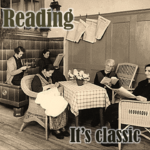
 In the intro cinematic for the popular Medieval fantasy video game, Skyrim, the player finds herself in a wagon full of prisoners being hauled to a fort for punishment. When the wagon arrives, one of the prisoners mutters that it’s “the end of the line.”
In the intro cinematic for the popular Medieval fantasy video game, Skyrim, the player finds herself in a wagon full of prisoners being hauled to a fort for punishment. When the wagon arrives, one of the prisoners mutters that it’s “the end of the line.”
Did a nasty squealing-to-a-halt sound just rip through your mind? Then you must know that “end of the line” is railroad terminology. The phrase has no place in a pre-industrial setting like Skyrim.
Historical fiction and fantasy occasionally stumble over technologically misplaced language that can knock informed readers out of the story. (Or informed viewers … check out this piece on the timeliness of fonts in the TV series “Mad Men.”) If you want to avoid jarring and alienating your smartest fans, it can help to know the technological origins of some of English’s common words and phrases.
In this new series, I’ll introduce you to some terms you might not know originated in a specific technology. If the tech’s not part of your setting, you can detour around the terminology. On the other hand, if it is part of your setting, you can find interesting ways to use the jargon!
And, although the series is called “Timely Terms,” it’s not merely about anachronism; if your setting is a desert world with no oceans (and therefore no sailing) you might want to avoid language derived from the Age of Sail. But, let’s get started with the first topic, suggested by Skyrim: the railroad. Continue reading


 Last week, during my son Jack’s visit, we spent a lot of time in bookstores.
Last week, during my son Jack’s visit, we spent a lot of time in bookstores.
 In a damn* interesting piece yesterday at Talk To YoUniverse, Juliette Wade discusses how writers can navigate the differing perspectives of characters inside and outside a culture group.
In a damn* interesting piece yesterday at Talk To YoUniverse, Juliette Wade discusses how writers can navigate the differing perspectives of characters inside and outside a culture group.
 You’ve come a long way, baby! I mean … um … ladies.
You’ve come a long way, baby! I mean … um … ladies.
 So, I walked to work today.
So, I walked to work today.
 In order to support the historical fiction writers out there, let me suggest a few books on The Longhouse, the confederacy of “Iroquois” nations (they called themselves Haudenosaunee) during the colonial period preceding the American Revolution.
In order to support the historical fiction writers out there, let me suggest a few books on The Longhouse, the confederacy of “Iroquois” nations (they called themselves Haudenosaunee) during the colonial period preceding the American Revolution.
 Oh where does the time go? Is it Thursday already?
Oh where does the time go? Is it Thursday already?